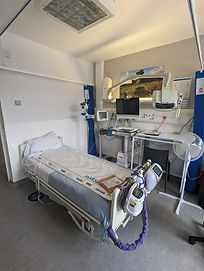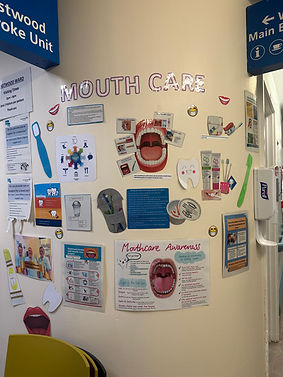
Eastwood Ward

The ward is a 35 bedded unit, with 5 of these beds belonging to HASU. We care for both acute and rehab patients until they are at a stage of a safe discharge or we care for them within their last hours or days.
LEM (Learning Environment Manager) Sam Goodwin
01246 512344.
Should you be absent for any reason please contact the ward and ask to speak to the nurse in charge. You must report your reason for absence and anticipated return date as well as contacting university.
It is well documented that strokes are the 3rd largest cause of death in the U.K. as such the Government and the Department of Health are investing time and money into raising awareness and increasing the specialist stroke services that are available.
Strokes are caused by a disturbance of blood supply to the brain. The world health Organisation definition of a stroke is,
'a clinical syndrome consisting of rapidly developing clinical signs of focal disturbance of cerebral function lasting more than 24 hours or leading to death with no apparent cause other than vascular origin.'
There are two main types of stroke:
Ischaemic stroke: These are the most common and occur when a clot narrows or blocks a blood vessel reducing the oxygen supply to the surrounding cells resulting in the death of those cells.
Haemorrhagic stroke: These occur when a blood vessel bursts and blood leaks into the brain causing damage.
Transient Ischaemic Attacks (TIA): also known as a mini stokes are a major warning sign of stroke. The signs and symptoms of a TIA (Facial droop, weakness to arms and legs, slurred speech) are the same as these for a stroke but last for less than 24 hours. With the correct prophylactic treatment many people suffering from a TIA can be prevented from experiencing a full stroke.
Learning Opportunities
-
Care of the acute stroke patient
-
Care of the rehabilitation patient
-
NG/PEG insertion and care
-
Working within the multi-disciplinary team
-
Discharge planning
-
Stroke Clinic
-
Early Supportive Discharge Team
-
CT/MRI/Ultrasound scans
-
Thrombolysis
-
Working alongside Stroke Psychologist
-
Working alongside Research nurses
-
Family meetings/Discharge planning meetings
-
Assessing patients in the Emergency Department
-
NIHSS/ABCD2 assessments



Shift times:
Long Days (LD) 07:00 - 19:30
Mornings 07:00 - 14:30
Afternoons 13:30 - 21:00
Long Nights (LN) 19:00 - 07:30
The Students rota is planned in conjunction with their allocated time on the ward and their required hours.
Specific requests should be identified as early as possible as the rota is usually completed at least 4 weeks in advance. Any changes must be approved by the LEM or Matron.
Ward Telephone Numbers
01246 512344 (Main ward) and 01246 512926 (HASU)
Information
Total Anterior Circulation Strokes (TACS): Patients with this type of stroke exhibit 3 of the following features;
-
Unilateral weakness (and/or sensory deficit) of face, arms and legs.
-
Homonymous hemianopia
-
Higher cerebral dysfunction (Dysphasia, visuospatial disorder)
Partial Anterior Circulation Stroke (PACS): patients with this type of stroke exhibit 2 out 3 of the following;
-
Unilateral weakness (and/or sensory deficit) of face, arms and legs.
-
Homonymous hemianopia
-
Higher cerebral dysfunction (Dysphasia, visuospatial disorder)
Lacunar Stroke (LACS): patients with this type of stroke only exhibit one of the following features:
-
Unilateral weakness (and/or sensory deficit) of face, arms and legs.
-
Homonymous hemianopia
-
Ataxic hemiparesis
-
No evidence of higher cerebral dysfunction
Posterior Circulation Stroke (POCS):
-
Cerebellar or brain stem syndromes
-
Loss of consciousness
-
Isolated homonymous hemianopia
Staff you will work with on Eastwood ward;
Matron Sisters Nurses Healthcare Assistants Ward receptionists Nursing Associates
Social Workers Physiotherapists Dietitians Occupational Therapists Clinical Psychologists Doctors
Research Nurses Activities Coordinator Infection Control Speech and Language Therapists Pharmacists
The ward can facilitate 36 patients at any one time.
2 Hyper acute beds. 14 Acute beds 20 Rehabilitation beds.
HASU (Hyper acute stroke unit)
a 5 bedded level 2 care unit which nurses some of the sickest patients. This is where thrombolysis and our new ABC - ICH bundle is used, also where we refer to Sheffield for either neuro surgery or thrombectomy (if applicable). Thrombolysis has to be given within 4 and a half hours of symptom onset and Thrombectomy has to be completed within 6 hours of onset, but this includes transfer time to Sheffield.
There is a band 6 on every shift to carry the stroke bleep, which is how fast bleeps come through and the sisters go and asses in ED. We have a telemed so that consultants can be contacted 24/7 in case of a thrombolysis.
Whilst assessing patients we use a tool called NIHSS (National institutes of health stroke scale) https://youtu.be/wzjWAJgGjTw?feature=shared

Useful Links
Anatomy regarding the brain - https://youtu.be/p52QcpxczSQ?feature=shared
New stroke guidelines for this year - National Clinical Guideline for Stroke for the United Kingdom and Ireland Plain Language Summary
When patients are discharged from us they will receive an information pack to take home and they can opt in/out of a referral to their local stroke association. This enables stroke survivors to access help within their own home or care home - Stroke Association | Home.


